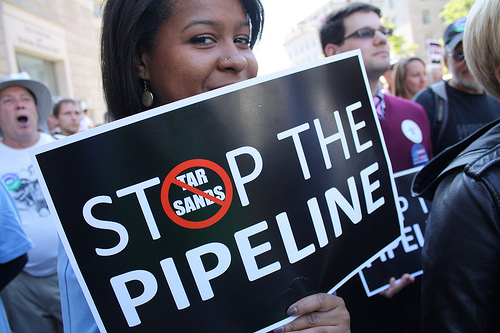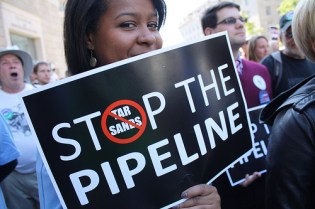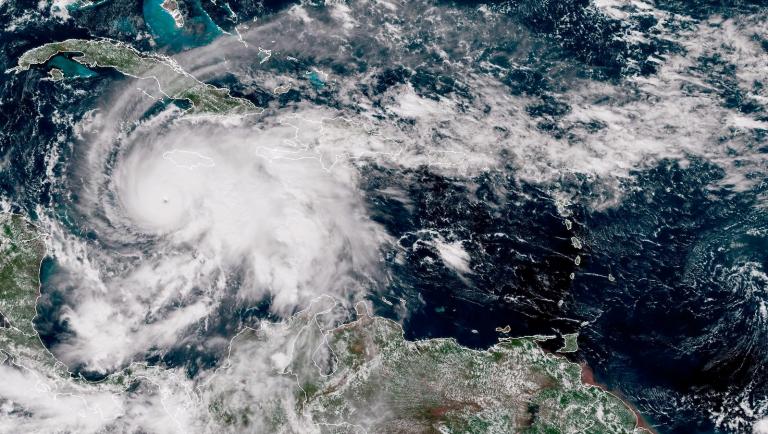In a nutshell
TransCanada, a Canadian corporation, wants to build a massive oil pipeline down through the middle of the U.S., more than 1,000 miles long and three feet in diameter. The Keystone XL would carry crude from the tar sands in Alberta, Canada, to refineries in Texas along the Gulf of Mexico.
As tar-sands oil is much dirtier and worse for the climate than regular old oil, this plan has climate hawks and many other sane people quite unhappy. The route as originally proposed would have gone through Nebraska and crossed about 250 miles of the Ogallala Aquifer, the nation’s largest underground source for drinking water and crop irrigation — a prospect that made lots of Nebraskan farmers, ranchers, and other folks unhappy. Now the route is up in the air — as is everything else about the pipeline.
Because the Keystone XL would cross national borders, the State Department would have to issue a permit for it to be built. After a lot of drama, State said no. But that was by no means the end of the story. Here’s how the situation has played out so far …
In a timeline
July 2008: TransCanada proposes Keystone XL.
June 23, 2010: Fifty Democratic members of the U.S. House write a letter [PDF] to Secretary of State Hillary Clinton pointing out — duh — that the pipeline would pose real risks to the environment and public health.
July 21, 2010: The U.S. EPA says the State Department did a crap job on its draft environmental impact study for Keystone XL, as it failed to consider the pipeline’s impact on the climate, among other things.
Oct. 15, 2010: Clinton says the State Department is “inclined to” approve the pipeline.
Oct. 29, 2010: Eleven Democratic U.S. senators express their displeasure at Clinton’s stated inclination, writing a letter that raises a red flag about Keystone’s climate implications.
December 2010: Environmental groups launch a coordinated campaign against the pipeline.
Aug. 20, 2011 – Sept. 3, 2011: Thousands of anti-Keystone activists demonstrate in front of the White House over the course of two weeks; 1,253 get themselves arrested.
Aug. 26, 2011: The State Department releases a final environmental impact statement on Keystone, finding that it would have “limited adverse environmental impacts.”
Oct. 7, 2011: The New York Times raises questions about a contractor that did key work on the State Department’s environmental impact statement, reporting that the company has financial ties to TransCanada.
Oct. 26, 2011: Fourteen Democratic senators and reps call for the State Department’s inspector general to investigate possible conflicts of interest in the environmental-review process.
Nov. 7, 2011: Thousands of anti-Keystone activists form a human chain around the White House to protest the pipeline.
Nov. 10, 2011: The Obama administration announces that it will delay a decision on the Keystone permit until 2013 (conveniently after the presidential election), allowing time to assess alternate pipeline routes.
Nov. 11, 2011: TransCanada starts considering alternate routes for the pipeline.
Nov. 30, 2011: Thirty-seven Republican senators introduce legislation that would force the Obama administration to make a decision on Keystone within 60 days — even though there’s now no agreement on a route.
Dec. 12, 2011: The Obama administration says that if forced to make a fast decision, that decision will be no.
Dec. 23, 2011: The Republicans’ 60-day ultimatum, attached to the payroll-tax-cut bill, is signed into law by President Obama.
Jan. 18, 2012: True to its word, the Obama administration says no to the permit, saying “the rushed and arbitrary deadline insisted on by congressional Republicans prevented a full assessment of the pipeline’s impact.” TransCanada says it will reapply for a permit.
Jan. 23, 2012: Republicans in Congress start introducing bills that would get the pipeline approved despite lack of cooperation from the White House and lack of a set route from TransCanada.
Feb. 9, 2012: The State Department’s inspector general finds that the environmental-review process for Keystone was not tainted by conflict of interest or bias, but notes some problems with the department’s analysis.
Feb. 13, 2012: Republicans in the Senate are trying to attach pro-Keystone legislation to a big transportation bill. Environmentalists are calling on citizens to “blitz the Senate with over 500,000 messages in 24 hours to demand they stop the pipeline.” You can join the blitzing here.
UPDATE: Feb. 15, 201: The blitz generates more than 800,000 messages to the Senate opposing the pipeline.
Read more:




